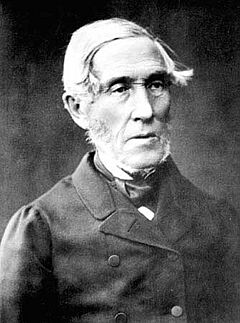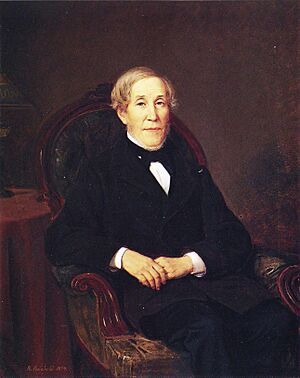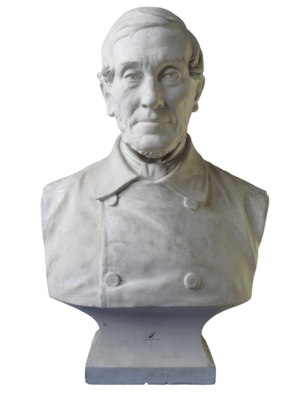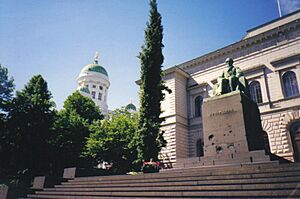Johan Vilhelm Snellman facts for kids
Quick facts for kids
Johan Vilhelm Snellman
|
|
|---|---|

J. V. Snellman in the 1870s.
|
|
| Born | 12 May 1806 |
| Died | 4 July 1881 (aged 75) |
| Alma mater | Royal Academy of Turku |
| Occupation | Philosopher, journalist, writer, politician |
Johan Vilhelm Snellman (12 May 1806 – 4 July 1881) was a very important Finnish thinker and politician. He was made a nobleman in 1866. Snellman was one of the main people who helped build Finnish national pride. He worked alongside other famous Finns like Elias Lönnrot and J. L. Runeberg.
Contents
Life and Early Career
Snellman was born in Stockholm, Sweden. His father, Kristian Henrik Snellman, was a ship's captain. After Russia took over Finland in 1808–09, Finland became a special area called the Grand Duchy of Finland. This meant it had some freedom. Because of this, his family moved to Kokkola, a town in Ostrobothnia, in 1813. Sadly, his mother died there just one year later.
Snellman went to the Royal Academy of Turku starting in 1822. He studied many subjects, including religion, history, Greek, Latin, and world literature. He also learned a bit about physics and other sciences. While at the university, Snellman became very interested in ideas about loving one's country and its culture. He wanted to focus on the future and the spirit of nations.
Moving to Helsinki and Teaching
In 1828, Snellman moved to Helsinki when the university moved there. By 1835, he became a lecturer at the University of Helsinki. He was part of a famous group of smart people like Cygnaeus, Lönnrot, and Runeberg. Snellman's lectures quickly became popular with students. However, in 1838, his teaching job was stopped for a while. This was because the government wanted to control new and different ideas among university staff.
Time in Exile and Return
Because of this, Snellman chose to leave Finland. He lived in Sweden and Germany from 1839 to 1842. When he came back to Helsinki, he was even more popular. But the political situation still made it hard for the university to hire him. Instead, he became the headmaster of a school in distant Kuopio. There, he started publishing strong opinion papers.
One of these papers was called Saima, written in Swedish. In it, he argued that educated people should start using the Finnish language. At that time, about 85% of Finns spoke Finnish. Snellman believed Finnish should become a language used for important things like school, art, and government. He thought this would help build Finland as a nation.
The government stopped Saima in 1846. In 1848–49, Snellman tried again to become a professor in Helsinki, but he was turned down. He thought about moving back to Sweden for good. In 1850, Snellman left his job in Kuopio and moved to Helsinki. He and his family had a tough time financially until Emperor Nicholas I died in 1855. After that, Snellman could once again publish papers about political issues.
He had married Johanna Lovisa Wennberg in 1845. They had five children together before she passed away in 1857.
Becoming a Professor and Senator
In 1856, Snellman finally became a professor. This made many politically active Finns very happy. However, Snellman's huge popularity didn't last forever. He was older than most of the younger politicians. He also supported the government, which had high hopes for Finland under Emperor Alexander II. The arguments over which language should be used in Finland, which he started, also caused many people to disagree with him. Lastly, his stance against the Polish rebels in 1863 made some people think he was just trying to please the government.
In 1863, Snellman was asked to join the Senate of Finland. This was like being a government minister, specifically in charge of money (Chancellor of the Exchequer). He was an energetic and valuable senator. He helped the Emperor issue a "language decree." This decree would slowly give the Finnish language the same importance as Swedish in the Finnish government. It also meant that the Parliament, which had been stopped since the Russian takeover, would start again.
A separate Finnish currency, the Markka, was introduced in 1860. Snellman managed to connect it to silver instead of the Russian ruble. This was incredibly important for Finland's economy. Snellman's time as Finance Minister was difficult because of the Finnish famine of 1866–1868. The government's strict money rules made it worse. But Snellman worked hard to get help while also trying to protect the new currency.
Snellman was very firm in his beliefs and had a strong voice in political discussions. His old reputation as a radical from the 1830s–1840s also caused a lot of people to oppose him and his ideas. In 1868, he had to leave the Senate.
For the rest of his life, he kept taking part in political debates. Since he was now a nobleman, he belonged to the Nobles' Chamber of the parliament. Snellman remained popular among his Finnish-speaking followers. However, he had become a very dividing figure in Finland's political world.
Honors and Legacy
Johan Vilhelm Snellman's image first appeared on a coin in 1960. This coin celebrated the creation of the markka currency in 1860. He was also chosen for a special €10 coin in 2006. This coin celebrated his 200th birthday. The front of the coin shows Snellman, and the back shows the beginning of Finnish culture.
A park in Kuopio, called Snellman Park (Snellmaninpuisto), is named after him. It used to be the location of the Kuopio Market Square. In the middle of the park, there is a bust (a statue of his head and shoulders) of J. V. Snellman. It was made by Johannes Takanen and revealed on July 3, 1886.
Snellman's birthday, May 12, is a special day in Finland. It is one of Finland's flag days, known as the "Day of Finnish Identity" or the "Finnish Heritage Day."
Works
In 1842, Snellman published his most important book, Läran om staten (which means Study of the State).





